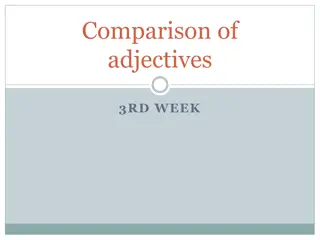Adjectives of the 3rd Declension
The nuances of adjectives belonging to the 3rd declension in Latin grammar. Gain insights into their forms, usage, and characteristics, enhancing your grasp of this essential aspect of the language.
Download Presentation

Please find below an Image/Link to download the presentation.
The content on the website is provided AS IS for your information and personal use only. It may not be sold, licensed, or shared on other websites without obtaining consent from the author.If you encounter any issues during the download, it is possible that the publisher has removed the file from their server.
You are allowed to download the files provided on this website for personal or commercial use, subject to the condition that they are used lawfully. All files are the property of their respective owners.
The content on the website is provided AS IS for your information and personal use only. It may not be sold, licensed, or shared on other websites without obtaining consent from the author.
E N D
Presentation Transcript
All the adjectives of the 3rddeclension are divided into three groups: 1) Adjectives with three three endings. 2) The adjectives with two two endings. 3) The adjectives with one form for all genders). one ending (one
masculinum femininum neutrum - -er - -is is - -e e er (Gen. sing. - -is is) (Gen. sing. - -is is) (Gen. sing. - -is is) These adjectives are rarely rarely used.
The stem of these adjectives is obtained from the Nominative ending: form by removing the feminine feminine puter, putris saluber, salubris putris, putre (rotten) salubris, salubre (healthy) stem salubr- stem putr-
masculinum, femininum - -is is neutrum (Gen. sing. - -is is) (Gen. sing. - -is is) - -e e Their dictionary form 1. Nominative form (ending in -is); 2. the neuter ending -e. dictionary form consists of two components: the common masculine and feminine front lis, e (frontal) dentalis, e (dental) brevis, e (short) cervic lis, e (cervical) occipitalis, e (occipital) labialis, e (labial)
The obtained removing the gender ending: stem of from the 2nd group Nominative adjectives form is by the vertebr lis tempor lis stem: stem: vertebr l- temporal- These adjectives are commonly commonly used.
The Nominative of such adjectives ends with - -s, s, - -r, r, - -x x. Dictionary form: 1) Nominative form (common for all genders). 2) Genitive ending with the stem part (Gen. sing. - -is is). simplex, cis simple mult plex, cis multiple teres, tis round par, paris equal duplex, icis double
The stem of such adjectives is obtained from the Genitive form singular by removing the ending. Dictionary form Gen. Singular simplex, cis mult plex, cis teres, tis Stem simpl cis multipl cis ter tis simpl c- multipl c ter t-
According to the 3rddeclension of adjectives decline: Participium praesentis activi (present participle active). Adjectives in the comparative degree.
This form is similar to the one-ending adjectives: recens, entis (fresh) afferens, entis (afferent) permanens, entis (permanent) incipiens, entis (incipient) Participle follows the noun and agrees with it: vas afferens (afferent vessel) dens permanens (permanent tooth)
m, f m, f ior ior, n , n ius ius G.sing G.sing. . ioris ioris anterior, anterius (anterior) posterior, posterius (posterior) superior, superius (superior) inferior, inferius (inferior) ductus inferior (inferior duct) linea inferior (inferior line) labium inferius (inferior lip)
Adjectives major, (small) translated degree: major, majus in in majus (big), minor, anatomical positive minor, minus terminology or minus are comparative Ductus sublingualis minor sublingual duct) Ductus sublingualis major duct) Foramen palatinum majus foramen) minor (minor (lesser) major (major sublingual majus (greater palatine
Adjectives take inflections to show difference in number, gender, and case, and they always agree with the nouns they go with To them To agree them in agree a a noun in the noun and the same and an Gender, Number an adjective Number and adjective means and Case means to Case. . to use use same Gender, arteria transversa (transversal artery) succus gastricus (gasrtic juice) tinctura aetherea (tincture etheric) extractum siccum (dry extract)
To agree a noun and an adjective you should: To agree a noun and an adjective you should: 1. determine gender, number and case of the noun; 2. determine group of the adjective by its dictionary form; 3. agree the adjective and the noun by gender, number and case.
Numerus / Casus Numerus / Casus 1 1st stgroup group 2 2nd ndgroup group Comparatives Comparatives m f n m f n m, f n -er -is -e -e 3 endings -us, -er, -os -um, -on Singularis Singularis -a -is -s, -x, -r -ior -ius 2 endings N. 1 ending -i -ae -i -is -ioris - iores G. -i -ae -a -es -ia -iora N. Pluralis Pluralis - - rum - rum -ium -iorum G. rum
ADJECTIVE SUFFIXES
of or pertaining to medianus, a, um median - - n (Eng. -an) n- -us, us, a, a, um um like; having; nature of, quality of destillatus, a, um destillate - - t (Eng. -at-e) t- -us, us, a, a, um um belonging nature of to; uterinus, a, um uterine - - n (Eng. -in-e) n- -us, us, a, a, um um causing, making incisivus, a, um incisive - - v v- -us, (Eng. -iv-e) us, a, a, um um multitude, similarity; full of, having squamosus, a, um venosus, a, um squamous venous - - s (Eng. -(e)ous) s- -us, us, a, a, um um
- -c (Eng. -ac) c- -us, a, um us, a, um cardiacus, a, um pertaining to cardiac - - c c- -us, a, um (Eng. -ic) us, a, um belonging to; nature of, like traumaticus, a, um traumatic connected with or belonging to; tending to - - d (Eng. -id, -id-e) d- -us, a, um us, a, um fluidus, a, um acidus, a, um fluid acid, sour
- -r (Eng. -ar, -ar-y) r- -is, e is, e belonging to, pertaining to auricularis, e capillaris, e auricular capillary - -( (ic ic) ) l l- -is, e (Eng. -(ic)al) is, e belonging to bronchialis, e bronchial - - l l- -is, e (Eng. -il-e) is, e relating to, suited for, capable of febrilis, e febrile passive possibility; worthy of - -(a) (Eng. -(a)bl-e) (a)b l b l- -is, e is, e operabilis, e operable























